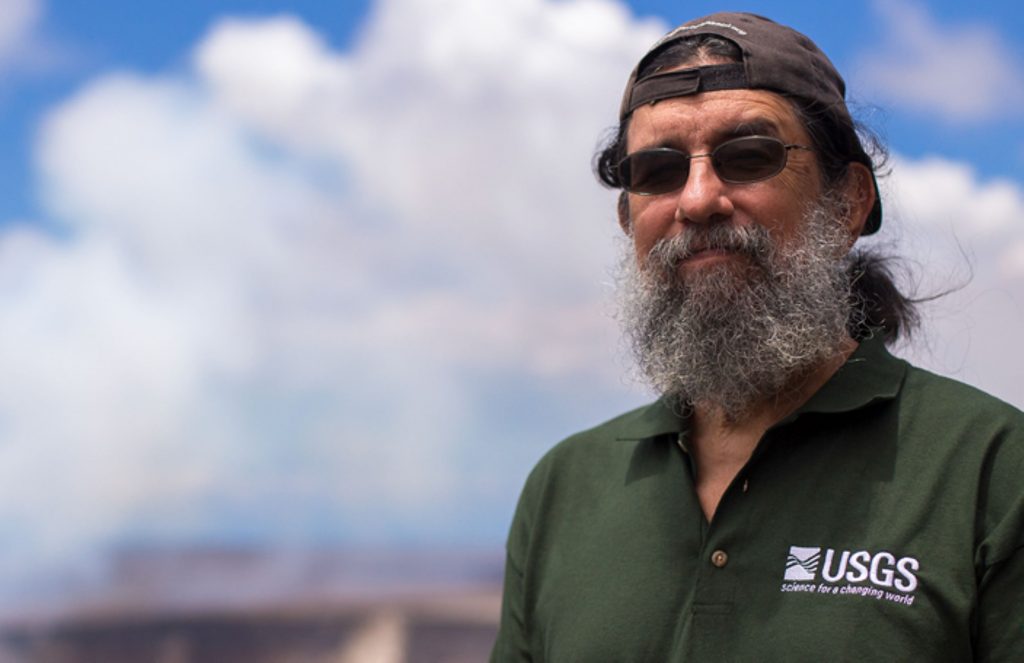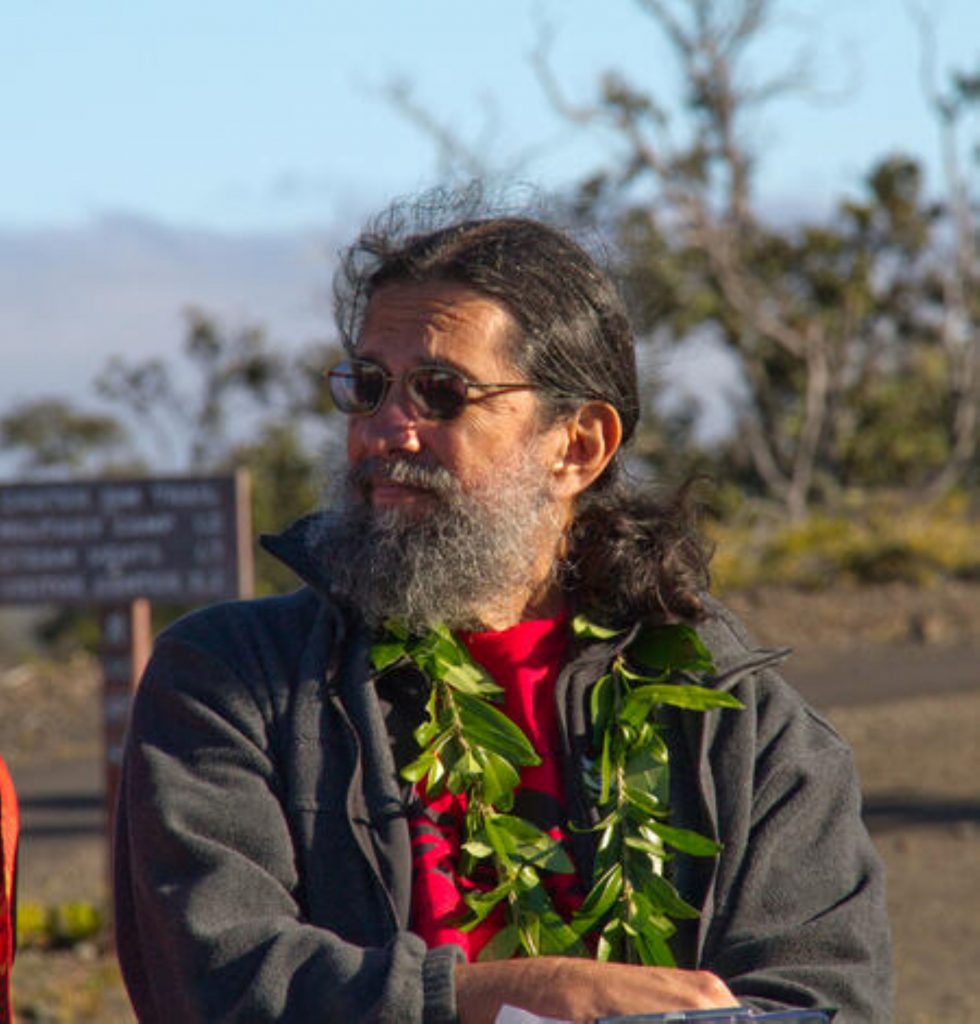Noted geophysicist, former scientist-in-charge at Hawaiian Volcano Observatory Jim Kauahikaua dies

The Big Island scientific community suffered a huge loss on Oct. 8 with the passing of Jim Kauahikaua, a noted geophysicist and former scientist-in-charge of the Hawaiian Volcano Observatory.
Kauahikaua died at his home in Hilo, with his family by his side, after suffering from a series of complications related to meningitis. He was 72.
“Jim was dedicated and passionate about understanding volcanoes — and equally passionate about helping others understand so they could be respectful of the power and be informed about essential safety issues while living on an active volcano,” said Jeri Gertz, his wife of 35 years. “He frequently served as a liaison between the volcano observatory and the public. People rightly felt they could always trust Jim to give calm, clear information to gain understanding in a volatile situation.”
Known for his iconic beard and ponytail, and affectionately called Dr. Jim by many, Kauahikaua joined the volcano observatory’s staff in 1988. Six years later he became scientist-in-charge, the first Native Hawaiian to serve in the position. He held the post for 10 years until stepping down in 2015 to rotate back to his former position.
He was still working for the observatory when he died. His colleagues and friends are still adjusting to his loss.
“It’s gonna be odd continuing on without being able to pick up the phone and ask Jim about something,” chief field engineer Kevan Kamibayashi said.
Kamibayashi and his team were trying to recall an agreement involving equipment on Maunakea toward the end of last week when he said they should “just ask Jim.”
“As soon as I said it, I was like, aw man, we cannot ask Jim,” Kamibayashi said.
Born Aug. 1, 1951, in Honolulu, Kauahikaua was a 1969 graduate of Kamehameha Schools-Kapalama. He received his bachelor’s degree in geology in 1972 from Pomona College and his master’s degree in geophysics in 1976 from the University of Hawai‘i at Mānoa. Kauahikaua received his PhD in geophysics in 1982 from UH-Manoa.
During his career, he served with the U.S. Geological Survey as a non-seismic geophysicist, focusing on using electrical geophysics in addition to magnetic field and gravity variations to study Hawaiian volcanoes and lava flows. After his time as scientist-in-charge, he focused more on researching the history of 19th- and early 20th-century Hawaiian volcanic eruptions.
Kauahikaua oversaw substantial changes in the observatory’s volcano and earthquake monitoring technologies and capabilities as the agency’s leader. A notable challenge he successfully managed was the use of $3.1 million from the 2009 American Recovery and Reinvestment Act, which led to many improvements but most importantly the expansion and digital conversion of the observatory’s monitoring networks.
He also coordinated the response to a number of significant volcanic and seismic events on the Big Island, including the 2004-05 Mauna Loa unrest, the 2006 destructive Kīholo Bay earthquake, the 2008 explosive opening of the Kīlauea summit vent within Halema‘uma‘u crater and the 2011 Kamoamoa fissure eruption, in addition to the ongoing Pu‘u‘ō’ō eruption, which ended in 2018.
Kauahikaua strengthened relationships and forged new ones between the observatory and other federal, state and Hawai‘i County agencies as well during his tenure as scientist-in-charge. He worked closely with Hawai‘i Volcanoes National Park, Hawai‘i Emergency Management Agency, Hawai‘i Department of Land and Natural Resources, Hawai‘i County Civil Defense and the Pacific Tsunami Warning Center to support interagency cooperation and collaboration.
A notable milestone of his time in the top scientist post was the Hawaiian Volcano Observatory’s centennial celebration in 2012. Kauahikaua also championed outreach and communication efforts, often leading the charge to increase public awareness of Hawaiian volcanoes and earthquakes.
He was also the author of the renowned hardcover book “Volcano: Creation in Motion (2004),” produced in partnership with photographer Brad G. Lewis.
Kauahikaua received a Citation for Meritorious Service, the second-highest U.S. Department of the Interior honor award, that can be granted to a career employee, in 2015.
Kamibayashi first met Kauahikaua when he was 11 during the Nä Pua No‘eau summer program at the University of Hawai‘i at Hilo. Kamibayashi signed up for the “Rocks and Rolls” geology class that had Kauahikaua as one of the instructors.
He said Kauahikaua was his mentor and credited him for sparking his interest in geology. It was also Kauahikaua who promoted Kamibayahsi to the observatory’s chief field engineer post in 2010.
“As a Native Hawaiian, seeing a Hawaiian who not only had his PhD but was doing work in science and the protection of life and property here in Hawai‘i, here at home, for our friends and families who live here and seeing a Hawaiian achieve those levels was a huge inspiration,” he said.
Kauahikaua also said the former scientist-in-charge was a hard worker and brilliant scientist with unparalleled institutional knowledge. They had a working relationship, but they were also friends. At the end of the work day Friday, they could still go get a beer and talk story about life. Their families also knew each other.
Kauahikaua was a regular person outside work; a gentle man who enjoyed music and spending time with his family and friends. He even was known to compose songs for retiring observatory staff.

The last time he saw Kauahikaua was in February while at the airport on his way to a meeting outside the islands. Kauahikaua and his wife were on their way to doctors’ appointments. That trip resulted in a four-month stint on O‘ahu because of health complications.
Kamibayashi wasn’t able to visit him after he returned to the Big Island and before he died.
“He’s always going to be an inspiration and a reason for how I got to where I am,” Kamibayashi said. “So I’ll truly miss him. It’s an honor to be able to share what little I can.”
Matt Patrick has been a geologist at the volcano observatory for 16 years. Kauahikaua was the one who hired him and he meant a lot to Patrick as his boss and mentor.
“I’ve always ultimately felt like I owed him my career at [the Hawaiian Volcano Observatory],” Patrick said. “I always felt like he took a chance on me and I think that’s why I really felt kind of indebted to him. The opportunities that he gave me at [the Hawaiian Volcano Observatory] have been incredible.”
Patrick said staff worked hard to meet Kauahikaua’s expectations. While it was tough at times, it was also rewarding because it brought out the best in them. He added that Kauahikaua also did his best to convey the meaning and purpose of the observatory as an organization that ultimately serves the community.
As a Native Hawaiian, connecting the culture with the observatory’s mission was something only Kauahikaua could do best. It was understanding the volcanic activity in the culture and understanding the role the observatory had in both.
“As someone from the mainland or someone who’s studying science on the mainland, you might come to the volcano and just think of it as a place that produces data that you can analyze,” Patrick said. “When you’re looking at [an] operational observatory that’s very closely integrated with the community, it’s important to get that sense and Jim was very good at conveying this – that the observatory is there to serve the community.”
Patrick said: “He really is irreplaceable.”
The observatory’s former outreach and media liaison Janet Babb said during her years working under Kauahikaua, he gave her latitude to develop and pursue projects that interested her, including launching Volcano Awareness Month in 2010, which has since become an annual observance.
There were challenges, especially with ongoing eruptions on Kīlauea, but there also were fun adventures with Kauahikaua, who was already a longtime friend before he became her boss. One of them was when they created and presented a virtual road trip highlighting historic lava flows that crossed the highway between Kaʻū and North Kona.
“I am forever grateful to Jim for his friendship, unwavering support and the many opportunities that I would have missed had he not believed in and supported me in my [Hawaiian Volcano Observatory] endeavors,” Babb said. “His passing is a huge loss for [the Hawaiian Volcano Observatory] and everyone who knew and loved him.”

Kauahikaua is survived by Gertz; daughter, Lilinoe Kauahikaua; brother, David Kauahikaua; brother-in-law, Mike Gertz; nieces, Ruthie and Sarah Gertz; and numerous cousins.
Services will be announced at a later date. Arrangements are being made by Ballard Family Mortuary. Click here to read his obituary online.
Sponsored Content
Comments








